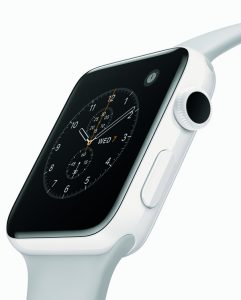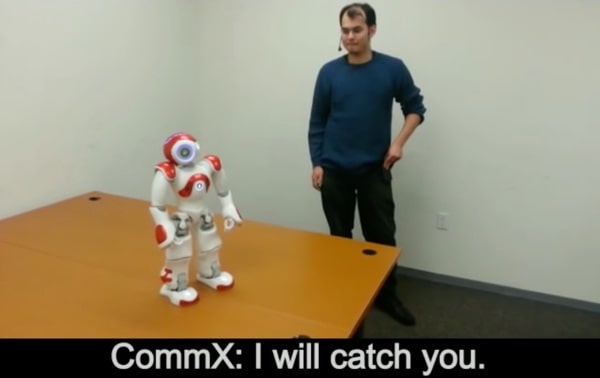Your Apple Watch Could Eventually Become a Complete BioMed Lab
Could augmented eyeglasses someday help us spot nasty viruses on public doorknobs? Could our wearables, in the form of an Apple Watch, someday provide a complete analysis of our blood? Predict a cold? Detect and diagnose a disease or illness? All that may not be far off.

The blood analysis laboratory of the future.
One of the features of modern tech is that projects that start off at a basic level and succeed almost always advance in ways that seem predictable and inevitable. This week, I want to focus on the practical, realtime benefits of a medical wearable that’s several generations beyond the current Apple Watch.
Here’s a good starting point via Jonny Evans. “Your Apple Watch is Going to Become Your Personal Physician.”
Author Evans makes some great points, but I want to elaborate myself.
AI + Miniaturization = Future
I have noted recently that CBC blood tests that used to require sending blood to a distant lab with big machines can now be done in a doctor’s office on a machine the size of a large bread box in just a few minutes. How long until your Apple Watch is able to conduct a complete, non-invasive, blood analysis?
I mention this because I’ve read about a technique that allows for the measurement of blood sugar in a person’s sweat. If that can be done, there may be ways in the future, not yet envisioned, to get even more detailed information about the blood non-invasively. And, therefore, create a very thorough profile of a person’s health.
Early on, some of this technology may start off as larger equipment in the home. That equipment transmits information about blood measurements to our iPhone for analysis and integration into other health data. But, I think, eventually, the “blood lab” will move into the wearable itself.
Taking this a step further, Siri or an IBM/Watson-like AI analysis of all that data could lead to the elimination of general practice physicians. Only when we need surgery would we have to visit a specialist. And that specialist will be a very precise, very competent AI robot.
Your Apple Watch tells you your pulse today, but a lot more is coming. “If we can dream it, we can do it.” (Walt Disney.)
Next page: The news debris for the week of January 16th. An Apple invasive maneuver.
Page 2 – News Debris for the Week of January 16th
An Apple Invasive Maneuver
I don’t know what to think of this first item. Yet. It could be a mistake by Apple. Or it could be something more insidious, agenda driven and just plain lame. Deserving of scorn. But until it all sorts out and I learn more, I’m just going to pass this on. “No internet connection? Be prepared for iTunes to drive you crazy.”

The gist is that as of iTunes 12.5.4, you’ll be unable to play your music in iTunes, even songs you’ve ripped from a purchased CD, without incessant pestering to have an internet connection. (I’ve communicated with Kirk McElhearn, and he confirmed that this applies to any song.) Author McElhearn writes:
But what if you don’t have internet access? Your connection is down; or your router is broken; or you simply don’t want your computer to connect to the internet? Well, iTunes will remind you of this, over and over and over. In such a case, iTunes will pop up an alert every single time you play a song and every time one song finishes and another one begins.
Apple couldn’t possibly believe that this is a good thing to add to a music player that may not be on the internet, trying to play personally ripped music from CDs. If they do, there will be much to talk about. Or it could have been a careless decision that will be remedied in the next release. Stay tuned because I will be monitoring this closely.
[UPDATE: This issue appears to be fixed in iTunes 12.5.5, released January 23, 2017.]
More Debris….
On the AI front, I’ve found a couple on interesting entries. The first involved the well-known exponential effect of AI. Right now, humans design AIs. When we get to the point where AIs help human design AIs, progress will escalate. In turn, when AIs alone design AIs the effects will be exponential. Now this article doesn’t delved into that specifically, but its a taste of what’s in store. “Artificial-Intelligence Developers: We’re Thinking beyond Autonomous Cars.”
For entry #2, I ran across this topic last week, but couldn’t find the recent reference again. The original discussion is from early 2016, so that’s the best reference I have right now. It’s worth revisiting. It all has to do with the conditions under which an AI or robot/AI might refuse an order from a human being.
“Why robots need to be able to say ‘No’.” Fascinating.

Robot refuses order to advance. It’s not safe. Until human says he’ll catch it.
There is, I think, an emerging trend in software driven services on the internet. Namely, the capabilities, computer languages and budgets for human beings to build the grand services that can be envisioned is outstripped by the complexity of the code and the scope of the project. In other words, it seems no amount of testing can ensure that a grand service delivery project can function at a high level at the outset. As a result, services are rolled out that frustrate rather than delight. Even Apple is subject to this effect, although I think Apple is better at it than many other companies. For example, “DirecTV Now is seriously broken.”
Have you noticed that Safari can’t play the latest 4K videos (posted after 12/6/2016) from YouTube? There’s a reason, and Rob Griffiths explains. “Safari and the YouTube 4K video problem.” Solution? Use Chrome.
Asking smart questions is always a good way to explore modern technology. The Street has some for Apple’s foray into original content.
I bring up the next item because it plays into modern tech and that’s always related to Apple. Namely, why do physicists make such good programmers? (I know. I was one.) I think it’s because so much of modern tech involves the representation of real world phenomena. A good example is asking a programming team at Pixar to represent flowing water. Or hair in the wind. The understanding of physical principles and the casting into code that visualizes is at play here. This physics expertise is also necessary for realistic games. More discussion here: “Move Over, Coders—Physicists Will Soon Rule Silicon Valley.”
In the early days of computing, input was via analog plugs and switches. Then came paper tape, magnetic tape and punch cards. Then we graduated to the command line. Then came the WIMP GUI, windows, icons, menus and pointer. Now, we’ve transitioned to the touch interface. That means the Mac is an endangered species. However. Dan Moren makes the case. “The case for a touchscreen Mac.”
Finally, does a corporation that holds and transmits private personal data and communications for its customers have the right to inform the customer when the government wants to see that data? At issue is whether a corporation can act on behalf of a customer’s Fourth Amendment rights. Here’s an good explanation of the issues. “Microsoft’s standing to sue over secret U.S. data requests in question.”
______________________
Particle Debris is a generally a mix of John Martellaro’s observations and opinions about a standout event or article of the week (preamble on page one) followed on page two by a discussion of articles that didn’t make the TMO headlines, the technical news debris. The column is published most every Friday except for holidays.
0 Response to "Your Apple Watch Could Eventually Become a Complete BioMed Lab"
Post a Comment